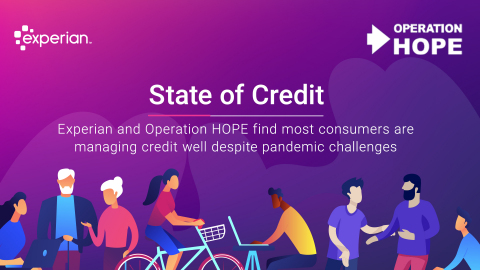Experian and Operation HOPE Find Most Consumers Are Managing Credit Well Despite Pandemic Challenges
Experian's 12th annual State of Credit report highlights that average U.S. credit scores have risen to 695, marking a 7-point increase since 2020. Factors contributing to this improvement include lower credit utilization rates and fewer missed payments. The report also introduces the HOPE Financial Wellness Index, which monitors credit scores across states, revealing Minnesota has the highest average score at 726. While overall credit management shows positive trends, challenges remain for many consumers, particularly those with limited credit histories.
- Average U.S. credit score increased to 695, the highest in over 13 years.
- Decrease in average credit card balances from $5,897 in 2020 to $5,525 in 2021.
- Reduction in average 30-59 days past due delinquency rates from 2.4% in 2020 to 2.3% in 2021.
- Some communities continue to face significant financial education and resource gaps.
- Average nonmortgage debt decreased only slightly from $25,483 in 2020 to $25,112 in 2021.
Average

Average
According to Experian’s report, many consumers were managing credit well before the pandemic’s arrival and the accommodations afforded by the Coronavirus Aid, Relief and Economic Security (CARES) Act may have helped consumers protect their financial health. At the same time, stay-at-home orders and record savings levels1 may have contributed to lower unsecured and total debt levels, lower credit utilization rates and fewer missed payments.
This year, Experian is partnering with Operation HOPE – the nation’s largest nonprofit dedicated to improving financial literacy – to launch the HOPE Financial Wellness Index, which highlights the average credit score in every state and city.
According to the index, consumers in
The HOPE Financial Wellness Index will be updated regularly and will be used to develop programming and identify communities most in need of financial education and resources.
“We believe credit education plays an important role in driving financial inclusion and helping consumers reach their fullest potential,” said
Given the unique circumstances of 2020, this year’s report compared credit trends over the last three years. While consumers took on more mortgage and auto debt, score improvements were supported by fewer missed payments, lower credit utilization rates and reduced card balances and total debt levels year-over-year and prior to the pandemic’s arrival.
Highlights of Experian’s State of Credit report include:
2021 State of Credit Report |
2019 |
2020 |
2021 |
|||||||
Average VantageScore® 2 |
682 |
688 |
695 |
|||||||
Median VantageScore |
687 |
697 |
707 |
|||||||
Average number of credit cards |
3.0 |
3.0 |
3.0 |
|||||||
Average credit card balance |
|
|
|
|||||||
Average revolving utilization rate |
|
|
|
|||||||
Average number of retail credit cards |
2.50 |
2.42 |
2.33 |
|||||||
Average retail credit card balance |
|
|
|
|||||||
Average nonmortgage debt |
|
|
|
|||||||
Average mortgage debt |
|
|
|
|||||||
Average auto loan or lease debt |
|
|
|
|||||||
Average 30–59 days past due delinquency rates |
|
|
|
|||||||
Average 60–89 days past due delinquency rates |
|
|
|
|||||||
Average 90–180 days past due delinquency rates |
|
|
|
“While consumers on average are managing their credit histories well, we know there are many communities in critical need of more financial education and resources,” said
Understanding generational differences
State of Credit also spotlights how each generation is managing their debts, showing scores have improved for every generation year-over-year. This trend is attributed to declining utilization rates and fewer missed payments. Credit utilization rates have declined for nearly every generation since 2019 except Gen Z who saw a slight uptick year-over-year. Similarly, credit card balances decreased for consumers of all age groups except Gen Z who increased their balances by
Across the board, consumers are missing fewer payments, with notable improvements seen among the youngest consumers. Gen Z decreased their 90 – 180 days past due delinquency rate by 29 percent year over year to 1.73 in 2021. This is a 72 percent decrease from the same period in 2019. Millennials also decreased their 90 – 180 days past due delinquency rates to 1.73 percent in 2021, down from
Additional 2021 generational findings from Experian’s State of Credit report include:
2021 findings by generation |
Gen Z |
|
|
Gen Y |
|
|
Gen X |
|
|
Boomers |
|
|
Silent |
|||
Average VantageScore® |
660 |
|
|
667 |
|
|
685 |
|
|
724 |
|
|
730 |
|||
Median VantageScore |
674 |
|
|
678 |
|
|
699 |
|
|
755 |
|
|
741 |
|||
Average number of credit cards |
1.7 |
|
|
2.7 |
|
|
3.3 |
|
|
3.4 |
|
|
2.7 |
|||
Average credit card balance |
|
|
|
|
|
|
|
|
|
|
|
|
|
|||
Average revolving utilization rate |
|
|
|
|
|
|
|
|
|
|
|
|
|
|||
Average number of retail credit cards |
1.6 |
|
|
2.1 |
|
|
2.5 |
|
|
2.5 |
|
|
2.1 |
|||
Average retail credit card balance |
|
|
|
|
|
|
|
|
|
|
|
|
|
|||
Average nonmortgage debt |
|
|
|
|
|
|
|
|
|
|
|
|
|
|||
Average mortgage debt |
|
|
|
|
|
|
|
|
|
|
|
|
|
|||
Average 30–59 days past due delinquency rates |
|
|
|
|
|
|
|
|
|
|
|
|
|
|||
Average 60–89 days past due delinquency rates |
|
|
|
|
|
|
|
|
|
|
|
|
|
|||
Average 90–180 days past due delinquency rates |
|
|
|
|
|
|
|
|
|
|
|
|
|
A strong credit history and responsible credit management can help consumers save thousands of dollars over a lifetime. For example, a person with a low credit score may pay close to
“Understanding the information included in your credit report and how it impacts your credit scores is one of the best ways to protect your financial health,” said
In addition to the free weekly credit report at annualcreditreport.com, Experian also offers consumers free access to their credit report and ongoing credit monitoring at Experian.com.
Additional credit education resources and tools
-
Join Experian’s #creditchat hosted by @Experian on Twitter with financial experts every Wednesday at
3 p.m. Eastern time . Bilingual and Spanish speakers are also invited to join Experian’s monthly #ChatdeCredito hosted on Twitter at3 p.m. Eastern time beginningSeptember 16 . - Visit the Ask Experian blog for answers to common questions, advice and education about credit.
- Add positive telecom, utility and streaming service payments to your Experian credit report for an opportunity to improve your credit scores by visiting www.experian.com/boost5
- For additional resources, visit http://www.experian.com/consumereducation
Analysis methodology
Experian’s analysis is based on a statistically relevant sampling of Experian’s consumer credit database, available on the Experian Ascend Technology PlatformTM, from Q2 2019, 2020 and 2021. Analyzed credit reports contained no personally identifiable information. Credit scores are based on VantageScore (range 300–850).
About Experian
Experian is the world’s leading global information services company. During life’s big moments — from buying a home or a car to sending a child to college to growing a business by connecting with new customers — we empower consumers and our clients to manage their data with confidence. We help individuals to take financial control and access financial services, businesses to make smarter decisions and thrive, lenders to lend more responsibly, and organizations to prevent identity fraud and crime.
We have 17,800 people operating across 44 countries, and every day we’re investing in new technologies, talented people and innovation to help all our clients maximize every opportunity. We are listed on the
Learn more at www.experianplc.com or visit our global content hub at our global news blog for the latest news and insights from the Group.
Experian and the Experian trademarks used herein are trademarks or registered trademarks of Experian and its affiliates. Other product and company names mentioned herein are the property of their respective owners.
About Operation HOPE
Since 1992, Operation HOPE has been moving America from civil rights to "silver rights'" with the mission of making free enterprise and capitalism work for the underserved—disrupting poverty for millions of low and moderate-income youth and adults across the nation. Through our community uplift model, HOPE Inside, which received the 2016 Innovator of the Year recognition by
For more information: www.OperationHOPE.org. Follow the HOPE conversation on Twitter, Facebook and Instagram.
1 https://www.bea.gov/data/income-saving/personal-saving-rate
2 VantageScore is a registered trademark of
3 https://www.urban.org/sites/default/files/publication/99021/what_is_the_cost_of_poor_credit_1.pdf
4 https://www.fool.com/the-ascent/banks/articles/heres-how-much-bad-credit-will-really-cost-you/
5 Results may vary. See Experian.com for details
View source version on businesswire.com: https://www.businesswire.com/news/home/20210908005043/en/
Experian Public Relations
1 714 460 3739
amanda.garofalo@experian.com
Lalohni Campbell
Operation Hope Public Relations
404-593-7145
la@persemediagroup.com
Source: Experian
FAQ
What is the average U.S. credit score in 2021 according to Experian?
Which state has the highest average credit score according to Experian's report?
What is the purpose of the HOPE Financial Wellness Index launched by Experian?







